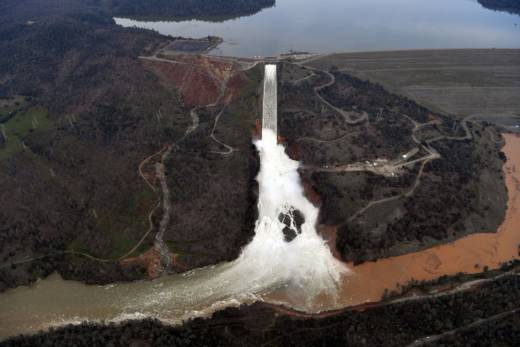The report calls the agencies "negligent" in failing to identify and correct the spillway problems -- flaws the study says dated back to its construction and resulted in repeated cycles of serious damage and extensive repairs.
"We have concluded DWR and DSOD should have taken the steps to update the design, construction, operations and maintenance facilities so as to satisfy its documented statutory, regulatory and management responsibilities," the report says. "A superficial ‘patch and pray’ approach is not an acceptable safety and risk management process for important public infrastructure systems."
Bea's first report, released in April, concluded that substandard design, construction and maintenance of the spillway led to the Feb. 7 breach. A preliminary list of "possible physical factors" from an expert forensics panel appointed to investigate the spillway failure later cited many of the same potential causes discussed in Bea's initial analysis.
Asked for comment, DWR spokeswoman Erin Mellon said in an email: "The forensic team, a collection of internationally respected scientists with dam safety and engineering expertise, continues its comprehensive assessment of the cause of the failure and we expect their report to be completed this fall. In the meantime, we welcome additional analyses and studies and will ensure this report is shared with the forensic team."
FERC did not respond immediately to a request for comment.
Bea's second report, delivered in testimony to the Legislature in May, included a series of recommendations to overhaul the DWR's project management, inspection and maintenance practices.
All three reports were produced under the auspices of UC Berkeley's Center for Catastrophic Risk Management. Each of the studies has included analyses performed by a wide array of independent researchers -- some of whom first posted their findings and speculations in the Free Republic and Metabunk online communities -- and reviewed by Bea.
The report released Thursday also delves into ongoing maintenance issues at the dam, citing years of DWR inspection reports that have documented possible problems with the massive concrete structure that supports the spillway gates and with an area of persistent moisture -- which has come to be known in official documents as "the green spot" -- on the downstream face of the dam.
The study suggests those issues put the entire dam complex at risk of failure. The Department of Water Resources has not commented on the spillway gate issue.
DWR has said -- for instance, in a page of frequently asked questions -- that the dam is sound and has never been at risk.
The department has also attributed green areas on the dam to rainfall and noted green areas first appeared on the structure before the reservoir behind it, Lake Oroville, filled in 1968.
On Friday, DWR spokeswoman Mellon said the department is "working on a preliminary report explaining the green spot. ... There has also been an on-going evaluation and there will be a subsequent final report on this longstanding issue."
The agency is in the midst of a crash construction program to replace parts of the shattered spillway before autumn rains begin. Omaha-based Kiewit Infrastructure West is working to replace the lower part of the structure this year, then demolish and replace the upper section in 2018.
The work this year also involves installing a 1,700-foot-long wall to protect the dam's emergency weir. Severe erosion occurred when water began flowing over that structure in February, threatening to undermine it and release a catastrophic torrent of water downstream. Concern about the weir's apparently imminent failure led to mass evacuations in Butte, Yuba and Sutter counties on Feb. 12.
